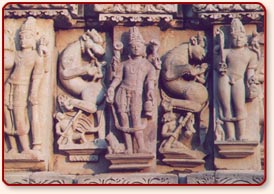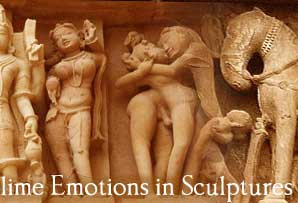 Khajuraho group of temples in Central India is one of
the most illustrious manifestations of Indian architecture. These
10th-11th century temples represent religiosity, patronage, artistic
genius and aesthetic sensibility all at once. Built in the typical
'Nagara' style of architecture, over 20 of the original 85 temples have
survived the climate for more than a thousand years despite being lost
into obscurity and hence, suffering neglect for a long period of time.
Believed to have been constructed during the Chandela rule, the temples
belong to Shaivism and Vaishnavism sects of Hinduism, Jainism and
'tantrism'. Unlike other temple complexes in the country, there is no
enclosure wall surrounding these temples and each of them on a high and
solid raised masonry platform. Though not very large, they have elegant
proportions and are adorned with sculptures on their exteriors and even
interiors.
Khajuraho group of temples in Central India is one of
the most illustrious manifestations of Indian architecture. These
10th-11th century temples represent religiosity, patronage, artistic
genius and aesthetic sensibility all at once. Built in the typical
'Nagara' style of architecture, over 20 of the original 85 temples have
survived the climate for more than a thousand years despite being lost
into obscurity and hence, suffering neglect for a long period of time.
Believed to have been constructed during the Chandela rule, the temples
belong to Shaivism and Vaishnavism sects of Hinduism, Jainism and
'tantrism'. Unlike other temple complexes in the country, there is no
enclosure wall surrounding these temples and each of them on a high and
solid raised masonry platform. Though not very large, they have elegant
proportions and are adorned with sculptures on their exteriors and even
interiors.These walled sculptures include depiction of numerous deities, their attendants, celestial maidens in sensuous positions and provocative postures, embracing couples (some of them in erotic sexual positions), dancers and musicians and couples engaged in various refinements of courtly love. It is believed that one temple alone sports over six hundred and fifty such figures ranging from sensual and warm depictions to explicit sexual activity (believed to illustrate the tantric rites by some). Some of these much-famed or much-notorious sexual postures are said to follow the Kama Sutra, the ancient Indian manual of art of making love. One of the most preferred destinations after Taj Mahal, Khajuraho has provided a scenic backdrop for many movies as well as many Indian classical dances that have been performed here.









